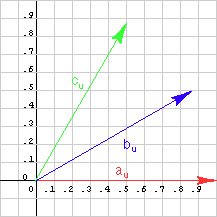Filtering out the effect of Length

bu is closer in orientation to au; so au · bu is the larger.
- au is (1, 0) --- a unit vector at zero degrees
- bu is (0.866, 0.5) --- a unit vector at 30 degrees
- cu is (0.5, 0.866) --- a unit vector at 60 degrees
Remember: cos 30° = 0.866, sin 30° = 0.5,
cos 60° = 0.5, and sin 60° = 0.866.
The dot products are:
- au · bu is 0.866
- au · cu is 0.500
So by using vectors of length one, the effect of length is removed and the dot product is larger when a small angle separates the vectors.
